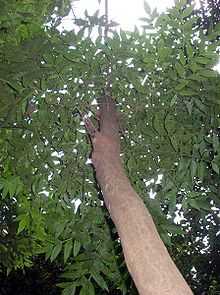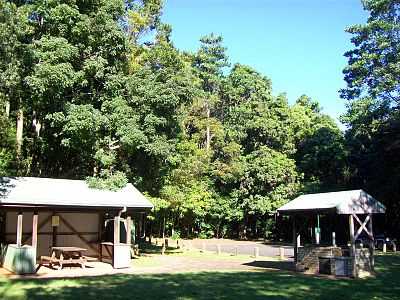Flindersia xanthoxyla
| Long Jack | |
|---|---|
 | |
| Scientific classification | |
| Kingdom: | Plantae |
| (unranked): | Angiosperms |
| (unranked): | Eudicots |
| (unranked): | Rosids |
| Order: | Sapindales |
| Family: | Rutaceae |
| Genus: | Flindersia |
| Species: | F. xanthoxyla |
| Binomial name | |
| Flindersia xanthoxyla (A.Cunn.) ex Hook. Domin | |
| Synonyms | |
| |
Flindersia xanthoxyla is an Australian rainforest tree in the citrus family. It is known as the Long Jack or Yellowwood. It occurs mainly in dry rainforest or littoral rainforest. However, it also occurs in sub tropical rainforest such as Davis Scrub Nature Reserve. The species name xanthoxyla means "yellow wood". The natural range of distribution is from the Richmond River, New South Wales to Gympie in south eastern Queensland.[1]
Taxonomy
Originally described by Cunningham as Oxleya xanthoxyla in 1830,[2] it was given its current name in 1930 by Karel Domin.[3] The species name xanthoxyla is derived from the Ancient Greek xanthos "yellow", and xylon "wood". It is a member of the genus Flindersia in the Rutaceae family.[4]
Description
A tree up to 45 metres in height,[4] and a trunk diameter of 90 cm. The trunk is cylindrical and straight with grey or brownish grey bark. The bark features vertical fissures, and it flakes off in plates. Small branches show distinct leaf scars, with a hairy down towards the ends, and on new leaflets and twigs.
4 to 11 opposite leaflets per compound leaf. Leaflets 2.2 to 13 cm long, 0.6 to 3.2 cm wide. Bright green above, duller below with a blunt leaf tip. Leaves dissimilar at the base, with one part of the leaflet broader and more curved than the other. Leaflet stalk 2 to 6 mm long, but the terminal leaflet has a longer stem, occasionally over 25 mm. Leaf mid rib and lateral veins easily seen above and below. Net veins less evident. Leaves of this species are quite small in comparison with other Australian rainforest plants of this Flindersia genus.
Flowers, fruit & regeneration
Yellow flowers form on panicles from June to September. Panicles are smaller than the leaves, and growing from the forks of leaves or at the end of branchlets. The fruit is a brown woody capsule, 7 to 10 cm long. Opening up in 5 valves. Each valve has a woody middle divide, and on each side are two or three seeds. Seeds includes thin seed "wings", which surround the heavier central part of the seed. Seeds dispersed by wind. Germination from fresh seed is relatively swift and reliable. Germination commences after three weeks, with an 85% success rate after two months.
Uses
An ornamental tree. Also planted for shade. Previously used for timber in the construction of coaches. Also cabinet making, flooring, tool handles, lining, ammunition boxes, artificial limbs and joinery. The timber has steam bending qualities.[5] The weight is between 575 and 900 kilograms per cubic metre.

References
- ↑ Floyd, A.G., Rainforest Trees of Mainland South-eastern Australia, Inkata Press 2008, ISBN 978-0-9589436-7-3 page 361
- ↑ "Oxleya xanthoxyla A.Cunn. ex Hook.". Australian Plant Name Index (APNI), IBIS database. Centre for Plant Biodiversity Research, Australian Government.
- ↑ "Flindersia xanthoxyla (A.Cunn. ex Hook.) Domin". Australian Plant Name Index (APNI), IBIS database. Centre for Plant Biodiversity Research, Australian Government.
- ↑ 4.0 4.1 "Flindersia xanthoxyla". PlantNET - NSW Flora Online. Retrieved 2010-06-17.
- ↑ "Flindersia xanthoxyla". Brisbane Rainforest Action & Information Network.
- ↑ Floyd, A.G., Australian Rainforests in NSW, volume 2, Surrey Beatty & Sons 1990, ISBN 0-949324-32-9 page 8